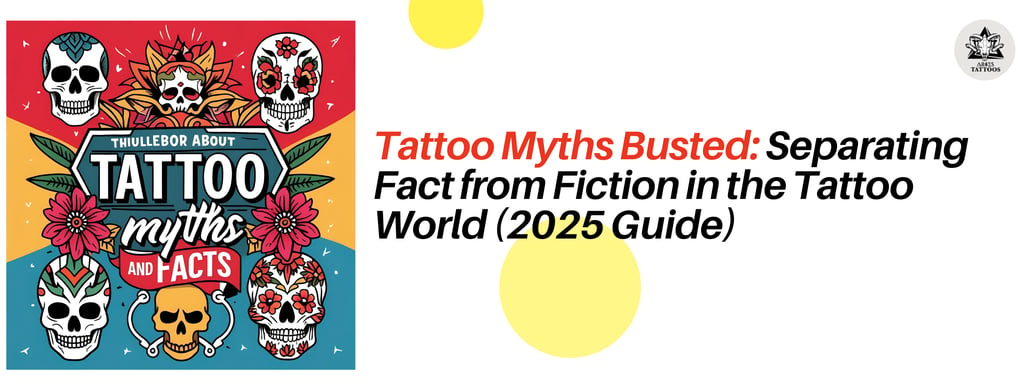Tattoo Myths Busted: Separating Fact from Fiction in the Tattoo World (2025 Guide)
This comprehensive guide examines the most common tattoo misconceptions, providing evidence-based facts about pain levels, blood donation restrictions, health concerns, tattoo longevity, and workplace acceptance. Ideal for both first-timers and experienced collectors, this article helps readers make informed decisions about body art based on current research rather than outdated beliefs.
Andy
5/21/20254 min read


Introduction
The world of tattoos is filled with myths, old wives' tales, and misconceptions that continue to circulate despite advances in tattooing technology and increasing mainstream acceptance. Whether you're considering your first tattoo or are a seasoned collector, separating fact from fiction can help you make informed decisions about body art. In this comprehensive guide, we'll examine the most persistent tattoo myths and provide evidence-based facts to help demystify the tattooing process.
Common Tattoo Myths Debunked
Myth #1: Tattoos Always Hurt Unbearably
FICTION: While tattoo pain is real, the experience varies dramatically based on:
Individual pain tolerance
Tattoo placement (areas with thin skin and close to bones typically hurt more)
The tattoo artist's technique
Your mental preparation
FACT: Many people describe tattoo pain as uncomfortable but manageable, similar to a continuous scratching sensation. Numbing creams and products are also available to help minimize discomfort during longer sessions.
Myth #2: You Can't Donate Blood After Getting Tattooed
PARTLY TRUE: The truth depends entirely on where you live and where you got your tattoo.
FACT: In most states with regulated tattoo facilities, you can donate blood immediately after getting tattooed in a licensed establishment. However, the American Red Cross imposes a 3-month waiting period if you received a tattoo in a state that doesn't regulate tattoo facilities. Always check current donation guidelines as they update periodically.
Myth #3: Tattoo Ink Causes Cancer
FICTION: To date, no conclusive scientific evidence links properly administered tattoo ink to increased cancer risk.
FACT: Modern professional tattoo inks are generally safe, though regulations vary by country. The FDA has increased oversight on tattoo inks in recent years. To minimize any potential risks:
Research your artist and studio thoroughly
Choose artists who use high-quality, reputable ink brands
Avoid cheap, unlicensed tattoo operations
Myth #4: Tattoos Fade Completely Over Time
FICTION: While tattoos do change over time, they don't simply disappear.
FACT: Tattoo longevity depends on several factors:
Ink quality and color (black and darker colors typically last longest)
Depth of ink placement
Sunscreen use and sun exposure
Skin type and aging
Placement on the body (areas with more friction fade faster)
With proper care, tattoos can remain vibrant for decades, though some touchups may be needed.
Myth #5: You Can't Get an MRI with Tattoos
FICTION: This myth originates from older tattoo inks that sometimes contained metallic components.
FACT: Modern tattoo inks rarely cause problems during MRIs. However, you should always inform your healthcare provider about your tattoos before undergoing an MRI. In extremely rare cases, tattoos may cause minor irritation during the procedure, but this is uncommon with contemporary inks.
Myth #6: Tattoo Removal is Quick and Easy
FICTION: Many people believe laser removal can erase tattoos completely in just a few sessions.
FACT: Tattoo removal is typically:
A lengthy process requiring multiple sessions (often 8-12 treatments)
Spaced 6-8 weeks apart for healing
More painful than getting the original tattoo
Not always 100% effective, especially with certain colors
Expensive (often costing more than the original tattoo)
Complete removal isn't guaranteed, and some tattoos may leave shadowing or scarring.
Myth #7: Tattoos Make You Unemployable
FICTION: While workplace stigma once existed, tattoo acceptance has dramatically increased.
FACT: As of 2025, approximately 40% of Americans have at least one tattoo. Many major corporations have relaxed or eliminated tattoo policies. Industries including tech, creative fields, healthcare, and education have become increasingly tattoo-friendly. However, some conservative professions and regions may still maintain restrictions on visible tattoos.
Myth #8: Getting a Tattoo While Pregnant is Safe
FICTION: While no definitive studies prove harm, most medical professionals recommend waiting.
FACT: Pregnancy concerns include:
Increased risk of infection when your immune system is already stressed
Potential unpredictable skin changes during pregnancy
Limited safe pain management options
The body's changing contours affecting tattoo appearance
Most reputable artists refuse to tattoo pregnant clients as a precautionary measure.
Myth #9: Tattoo Artists Can Copy Any Design You Bring
FICTION: Copyright laws and artistic ethics apply to tattoos just like other art forms.
FACT: Professional tattoo artists typically:
Won't copy another artist's custom tattoo design exactly
Need to modify copyrighted characters or logos
Prefer creating original work based on your inspiration
May refuse certain requests based on their artistic values
The best results come from collaborating with your artist rather than demanding exact replicas.
Myth #10: "Tattoo Blow-Outs" Only Happen with Inexperienced Artists
FICTION: Even the most skilled artists occasionally experience blow-outs.
FACT: Tattoo blow-outs (ink spreading beneath the skin causing a blurry appearance) can happen due to:
Individual skin differences
Challenging placement areas
Natural skin movement during healing
Client aftercare practices
While experienced artists have techniques to minimize risk, some anatomical factors are beyond their control.
Conclusion: Making Informed Tattoo Decisions
Understanding tattoo facts versus fiction helps ensure a positive experience with body art. The most important factors for a successful tattoo experience are:
Research extensively - both artists and studios
Communicate clearly with your chosen artist
Follow aftercare instructions meticulously
Understand the permanence and commitment involved
Make decisions based on facts, not hearsay
Whether you're getting your first tattoo or adding to your collection, separating myth from reality will help you navigate the process with confidence and achieve results you'll be happy with for years to come.
FAQs About Tattoo Myths
Q: Can people with tattoos use saunas and hot tubs?
A: Yes, once your tattoo is fully healed (typically 4-6 weeks), saunas and hot tubs are generally safe. However, chlorine exposure and extended soaking may gradually affect tattoo vibrancy over time.
Q: Do tattoos stretch significantly with weight gain?
A: Moderate weight fluctuations usually won't dramatically affect tattoos. Extreme weight changes might cause some distortion, particularly in areas prone to stretching like the abdomen or upper arms.
Q: Are white ink tattoos truly invisible under normal light?
A: No, white ink tattoos are visible, though more subtle than traditional tattoos. They often appear slightly raised and can yellow or fade unevenly over time. They're not reliable as "hidden" tattoos.
Q: Can tattoo ink interfere with sweat glands?
A: Research shows tattooing has minimal impact on sweat function. A 2019 study found only slight differences in sweat rate and composition in tattooed versus non-tattooed skin.
Q: Do tattoos make it harder to diagnose skin cancer?
A: Tattoos can potentially obscure skin changes, making regular skin checks important. Inform your dermatologist about tattoos during skin cancer screenings.
Have you encountered other tattoo myths? Share your experiences in the comments below!
Aries Tattoo Noida
We’re a leading tattoo studio in Noida, delivering top-notch services for over 7 years.
Connect with us
News letter
✉️ hello@ariestattooo.com
📞 +91-8076363878 / +91-8178083852
© 2025. All rights reserved | Made with ❤️ Aries Tattoo Noida
⏱️ Mon-Sun: 11AM - 9PM
